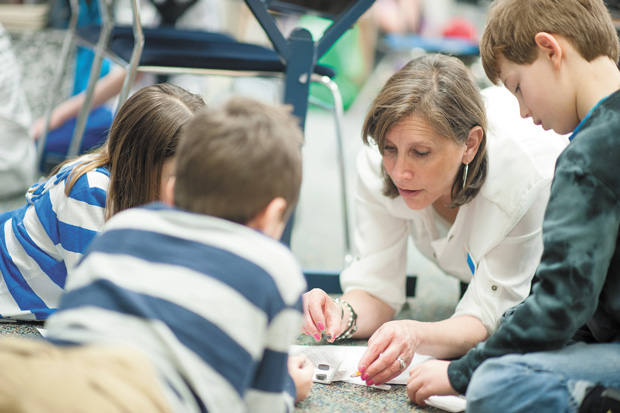STEAMing Ahead
Published April 2, 2014
Isaac Benjamin was skeptical as he worked to figure out which of the magnets, the round ones or the rectangular ones, were stronger. “What if it doesn’t work?” he asked his “co-innovators,” Ilana Boyer and Adli Jacobs, as the three sat on the floor fiddling with the magnets, trying to make them repel.
Adli voiced similar concerns. “We worry a lot,” he confided, explaining that he felt added pressure coming from a family of scientists and all. He said his mother is a plant scientist; his father, a bio-engineer. Both work at Monsanto.
“If I become a scientist, I’ll be carrying on the family tradition,” he explained, though he quickly — and proudly — added that his grandmother “is a famous artist in Winnipeg, Canada.”
Meanwhile, Ilana, the lone girl of the trio, took a longer view. “They’ve been looking at the dark side all day,” she said, pointing to Adli and Isaac. “We think we know how to do this. We are going to do this.”
“THIS,” their teacher, Sue Lapp, explained, was to create a “maglev train” using magnetic levitation to propel the train, rather than wheels, axles and bearings. With maglev, a train is levitated a short distance away from a guide rail using electromagnetic propulsion to create both lift and thrust, so there is no friction and it can go at very high speeds. Trains of this sort now operate in parts of China and Japan.
So with this in mind, Isaac, Adli and Ilana, and the other third graders at Saul Mirowitz Jewish Community School, were working in groups of twos and threes last Friday to build a mock maglev train and rail system, using magnets and cardboard. The key, it seemed, was placing the magnets to create repulsion, which in turn would make the cardboard guide rail float.
“Part of the experience is learning how to ‘fail forward,’ ” said Lapp, explaining that real-life innovators achieve success through trial-and-error, and must think boldly, even if their first attempts don’t work. They have to live with uncertainty and ambiguity, failure and resilience.
In a way, falling short in the short term was part of the long-term goal of the school’s first ever STEAM Day. Head of school Cheryl Maayan explained that each grade was participating in STEAM activities, integrating the disciplines of science, technology, engineering, art and mathematics.
“The world is changing. What we do in elementary and middle school sets the stage for these children’s success,” said Maayan. “The workforce is different than what it used to be. We need creative entrepreneurs and engineers. We need problem finders and problem solvers.”
Maayan explained that the STEAM activities integrate all of these disciplines rather than having children learn each in a silo. The concept builds upon the “Educate to Innovate” initiative set forth by the Obama administration, to provide students at every level with the skills they need to excel in the fields of science, technology, engineering and math (STEM), which build knowledge and skills for jobs of the future.
Mirowitz teachers adapted STEM to STEAM because they felt art is such a vital component of innovation and creativity. They also came up with a project for each grade level to correlate with what the students are studying.
Kindergarteners were challenged to launch three different-sized cardboard frogs as far and high as possible using simple machine levers while second graders built houses with increasingly stable materials, like the three little pigs. Eighth graders worked to build submarines that had to submerse, touch the bottom of a fish tank and come back up without mid-submersion adjustments (say what?).
Fourth graders Ellior Rose and Maya Lev worked together to build a wind-powered car. The challenge was to see which team’s car went the farthest when blown from behind by an electric fan.
The two girls — and all the other fourth graders — were provided with the same materials to make their cars: five drinking straws, a 4×6-inch index card, four lifesavers, 15-20 paper clips and one plastic bag as well as rubber bands, rulers, scissors, a sheet of paper, string and tape.
Ellior and Maya decided to build a six-wheel car instead of four — genius, I thought, it definitely would have more varoom and go the distance.
“It’s really so our file-card car doesn’t sag in the middle,” Maya explained.
Added Ellior: “I like that we can design our own car and if it doesn’t work, we can change the design, fix it. And I really like that we get to incorporate wind because wind cars save energy and help the environment.”
The girls then told me they had seen a video about a farmer in China who had built a wind car in only three months that could go up to 48 miles per hour. It even had the capacity to store wind for days when it wasn’t very windy.
From fifth graders designing bird’s nests that could hold the most mass to first graders building cars to go down a ramp to seventh graders constructing bridges that spanned 60 centimeters and could withstand increasing amounts of weight, students seemed genuinely engaged in these hands-on projects that had them thinking, drawing, building, measuring, evaluating and re-evaluating. While several sought assistance — and reassurance — from their teachers and others truly were bent on winning the challenge, most seemed to draw confidence from giving it their best shot and making adjustments along the way.
When I checked back with Isaac, Adli and Ilana after an hour to see how they were doing, Isaac flatly told me, “You know, this is a lot harder than it looks.” Nonetheless, the three clearly exemplified the STEAM spirit: If at first you don’t succeed, try, try again. An age-old lesson that not only resonated, but felt very modern.















